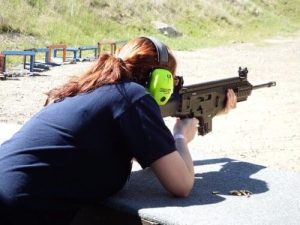
6 Tips for Buying Your First Gun
Updated: 10/9/2024
Are you a novice shooter and are buying your first gun soon? Congratulations! You are in luck, as Clinger Holsters has compiled some considerations, tips, and tricks as you search for your perfect fit for your gun holsters.
Why do you need it?
Why do you need a handgun? Concealed carry or home defense?
If you’re buying your first gun for concealed carry, you want it to be smaller, lighter, and less obtrusive.
If you’re buying your first gun for home defense, you may want something larger and heavier.
So… before you start shopping, figure out what you will use it for.
Now that you know the gun’s primary function, let’s look at styles.
Buying Your First Gun Step #1. What type of handgun style do you want?
When selecting a handgun for personal defense, you’ll find two primary styles to consider. Each has its unique advantages tailored to different needs and preferences.
Semi-Automatic Pistols: Semi-automatic pistols remain the predominant choice in today’s self-defense firearms market. Their popularity stems from several key features:
- Light and Consistent Trigger Pull: Modern semi-autos are designed with trigger systems that promote faster, more accurate shooting with less effort compared to other handgun types.
- High Capacity Magazines: Many models can hold 15 to 20 rounds, providing a significant advantage in self-defense scenarios where multiple threats might be present.
- Quick Reloads: The ability to quickly change magazines is critical in a defensive situation, and semi-automatics excel in this aspect.
- Compact Design: Generally, semi-automatics are slimmer than revolvers, making them easier to conceal without sacrificing grip comfort.
Revolvers: Despite the dominance of semi-automatics, revolvers still hold a significant place, especially among those who prioritize reliability and simplicity:
- Simplicity of Use: Revolvers are often favored for their straightforward mechanism, which can be ideal for individuals who find racking the slide of a semi-automatic challenging.
- Reliability: With fewer moving parts, revolvers are less likely to jam and are perceived as more reliable under various conditions.
- Capacity: Typically, revolvers hold 5 or 6 rounds, which is generally sufficient for many self-defense situations.
- Trigger System: Most modern revolvers employed for self-defense are equipped with a double-action trigger system, which means the pull of the trigger both cocks and releases the hammer. This can potentially increase firing speed but may require more trigger pull force.
Each type of handgun offers distinct benefits that can be matched to your personal defense needs, physical capabilities, and comfort level. Advancements in both semi-automatics and revolvers continue to enhance their efficacy, safety, and usability, making the choice between them more dependent on personal preference and specific use case scenarios.
Buying Your First Gun Step #2. Check your budget
Please read the following advice carefully—it could be crucial for both you and your wallet.
DO NOT let budget constraints be the sole deciding factor in your handgun purchase!
In 2024, the wisdom of buying a handgun remains centered on being thorough, precise, and prudent—this is particularly vital if you’re considering a pre-owned firearm. In the realm of firearms, opting for the cheapest option is seldom wise.
Acquiring a used firearm that may have hidden faults or issues can end up costing you more in the long run than if you had invested in a new one initially. This is because any underlying problems could necessitate unexpected repairs or adjustments, adding to the total cost of ownership.
Whenever you’re in the market for a used gun, make sure to have it inspected by a qualified gunsmith. They can examine every aspect of the firearm to ensure it’s in good working order and safe to use, helping you make a well-informed purchase decision.
Buying Your First Gun Step #3. Research handgun factors
Tip #1. Consider caliber size
There are a few popular calibers to choose from. The .45acp, 9mm, & 40S&W are the most popular for semi-autos. The .38 & .357 are most popular for revolvers. The size of the round, or caliber can determine how much recoil the gun will have and how effective the stopping power might be.
Tip #2. Think about recoil
A very common myth is that if I buy a small gun it will have less recoil the case is quite the opposite. Since a smaller weapon is [smaller] it has less mass to absorb the recoil of the weapon.
So a large weapon with a smaller caliber (e.g. Beretta M9) has much less felt recoil, whereas a small weapon with a larger caliber (e.g. Xds 45acp) has more aggressive recoil.
Tip #3. How much stopping power do you need?
As caliber sizes go up the effectiveness of the stopping power will increase. A .22 caliber round will not be as effective at stopping an assailant as a .44.
Tip #4. Compare firepowers
Full-size guns chambered in 9mm can hold as many as 18 rounds vs a similar gun chambered in 45acp which holds 10-12 rounds.
Usually, guns chambered in 45acp can’t hold as many rounds as a gun chambered in 9mm. Therefore, firepower should be considered as well.
Buying Your First Gun Step #4. Test out a few handguns
There are two very important things to remember when buying a handgun
- Comfort: Does the handgun feel right in your grip? A comfortable hold is crucial, especially if you plan to use it frequently.
- Control Accessibility: Are all the operational controls such as safety, slide release, and magazine release within easy reach? This can significantly affect your response time and safety.
- Natural Alignment: When you aim, does the gun align naturally with your target? A good fit should feel like an extension of your arm, without needing to adjust your wrist angle or stance drastically.
- Fit to Hand: Does the handgun conform to the contours of your palm? Proper fit can enhance both accuracy and comfort during shooting.
Tip #5. Performance and Testing
- Try Before You Buy: If possible, test the handgun yourself. Many gun shops connected to or partnered with shooting ranges offer the option to test fire guns.
- Rental Options: Look for ranges that provide rental options to try various models before making a purchase. This can be invaluable in finding the right handgun that meets your shooting style and comfort.
Always consider the primary use of the handgun before purchasing. Remember, no single gun excels in all scenarios. Having a variety of handguns for different purposes enhances your preparedness. Smaller guns, while harder to shoot accurately due to shorter sightlines and lighter weight, are more convenient for concealment. Conversely, larger guns, offering better stability and accuracy, are preferable when concealment is not a concern.
For those specifically looking for a concealed carry weapon, research the latest models recognized for their reliability, ease of concealment, and ergonomic design. The market in 2024 offers advanced options that combine lightweight, compact design with improved safety features, making them ideal for personal defense.
If you plan on concealing your new weapon, here is a breakdown of the best concealed carry guns on the market.
If you have any more questions about being a concealed carrier, check out our in-depth article here! and also check our Glock 23 holsters here





